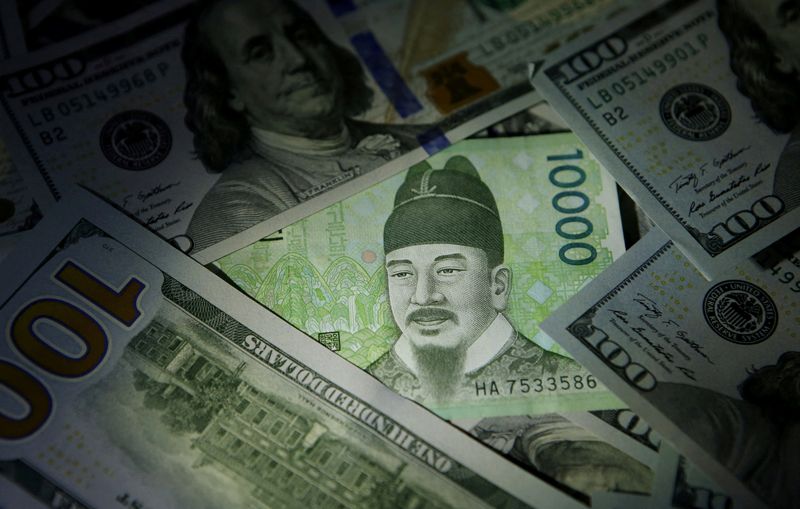By Sameer Manekar
(Reuters) – Bearish positions on most Asian currencies have strengthened, a Reuters poll showed on Thursday, rising steadily from the start of the year as interest rate cuts were repriced after strong U.S. economic data pushed the dollar higher .
Short bets on the Malaysian ringgit rose to their highest level since mid-July last year, while those on the Indonesian rupiah reached a five-month high, the fortnightly poll of 11 analysts showed.
The Korean won was the most shorted currency according to analysts surveyed, reaching its highest level since October 2022, while bears strengthened positions on the Singapore dollar to reach a six-month high.
A slew of strong U.S. economic data and persistent inflation prompted some Federal Reserve officials to temper market expectations about the large number of rate cuts this year, strengthening the dollar and casting a shadow on emerging market currencies .
“The stronger dollar trend has certainly contributed to the consternation among officials abroad, with the US to some extent exporting its inflation problem to other countries via the dollar,” wrote Michael Wan, senior currency analyst at MUFG.
Indonesia’s central bank reassured investors on Wednesday that it will intervene to keep the rupiah stable, which has fallen about 5% so far this year and is currently at a four-year low. The Bank of Korea also indicated its willingness to deal with volatile currency movements.
Analysts at HSBC expect the USD-Asia pairs to eventually moderate later this year, assuming the Fed begins its policy easing cycle, geopolitical risks are manageable and the USD-RMB remains “reasonably under control.”
“The risk is that Asian currencies may not recover even slightly and end up experiencing another year of depreciation if the Fed does not cut rates as a result of a reaccelerating US economy,” HSBC said in a note.
Meanwhile, short bets on the Chinese yuan moved higher, reaching their highest level since early November, even as the central bank continues to resist the depreciation.
Analysts turned bearish on emerging Asia’s best-performing currency, the Indian rupee, for the first time since mid-December.
“The INR weakness is catching up with the AXJ (Asia excluding Japan) weakness due to exogenous factors including a resurgence in high US longer term yields, persistent geopolitical risks in the Middle East and renewed volatility in the yuan and yen.” That’s according to Christopher Wong, currency strategist at OCBC.
However, Wong added that the rupee’s “softness pales in comparison to regional currencies” amid “carry allure, bond lock-in and expectations of policy continuity”.
The Asian currency positioning poll focuses on what analysts and fund managers believe are the current market positions in nine Asian emerging market currencies: the Chinese Yuan, the South Korean Won, the Singapore Dollar, the Indonesian Rupiah, the Taiwan Dollar , the Indian rupee, the Philippine peso, the Malaysian ringgit and the Thai baht.
The poll uses estimates of net long or short positions on a scale of minus 3 to plus 3. A score of plus 3 indicates that the market is significantly long on U.S. dollars.
The figures include positions via non-deliverable forwards (NDFs).
Below are the survey results (US dollar positions versus each currency):
DATE
18-Apr-24 1.25 1.59 0.8 1.32 1.24 0.43 1.42 1.19 1.28
4-Apr-24 1.18 1.09 0.42 1.13 1.17 0 1.15 0.62 1.35
21-Mar-24 0.92 0.82 0.33 0.6 0.92 -0.54 1.12 0.47 1.13
7-Mar-24 0.84 0.54 0.25 0.53 0.64 -0.59 1.14 0.52 1.05
22-Feb-24 0.7 0.4 0.2 0.2 0.7 -0.4 1.3 0.3 1.1
8-Feb-24 0.4 0.39 0.41 0.4 0.32 -0.17 1.07 0.28 0.72
25-Jan-24 0.37 0.9 0.28 0.51 0.49 -0.18 1.21 0.5 0.9

11-Jan-24 0.18 0.3 0.02 0.19 0.05 -0.15 0.72 0.09 0.03
14-dec-23 0.02 -0.09 -0.22 -0.05 -0.33 0.34 0.58 -0.22 0.16


